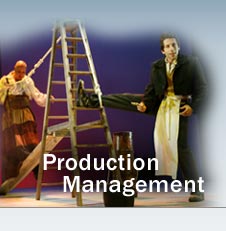It may not look it, but a stage is a potentially hazardous place, and the staging of Beasts and Beauties had more potential dangers to actors and stage technicians than most. The pyrotechnics used in 'The Juniper Tree', the dead brides in heavy metal cages dropping down to head height during the action in 'Bluebeard', and the pig who spills yoghurt onto and off the stage, almost into the laps of the front row of the audience in 'The Husband' are all memorable effects. But what if it all went horribly wrong? What if debris from the pyrotechnics landed on the audience, or an actor slipped and fell in the yoghurt? Luckily Garry Ferguson, the production manager, is there to prevent any mishaps and oversee
health and safety issues. He tells us about
assessing the risks of a production by examining the initial model of the set, talking to the designer and director, and to the department heads about any problems that they anticipate. During the rehearsals, especially the technical rehearsals, Garry is on the lookout for any potential hazards, like the use of water in proximity to electricity.
In an old theatre like the Bristol Old Vic, the
role of the production manager extends beyond the production to safeguarding the theatre itself. Garry must ensure that the condition of the building meets new safety legislation, a task that involves a lot of administration. The
use of pyrotechnics and smoke are two of the main concerns in an old, wooden building like the Bristol Old Vic, and an assessment must be made of the size of the pyrotechnics, where they will be placed, where the debris could fall, and any fire precautions that should be put in place. As well as the physical state of the theatre, there is also the financial side to
managing a production, and making sure that expenditures stay within budget while trying to accomodate the needs of different departments.
Behind the stage, the flymen are responsible for the safe and timely lowering and raising of backdrops and props. Head flyman Ken Smith
shows us the ropes of the two systems at the Bristol Old Vic. The first, now rarely needed, is the old way, involving the flyman using muscle power to pull on ropes attached to a bar, where props or backdrops can hang suspended above the stage, in the 'flies', until needed. In the nineteenth century, when the Bristol Old Vic was a thriving local theatre, the wooden gallery above the stage from where the flymen worked would be crowded by up to twenty or more men, many of them ex-sailors from Bristol's busy port, heaving on ropes to raise and lower the scenery just as they had once heaved on heavy sails to get them aloft.
Today however, a more modern system is easier on the muscles, requires only one or perhaps two people to operate it, and uses a cradle loaded up with weights to counterbalance whatever is attached to the bar.

